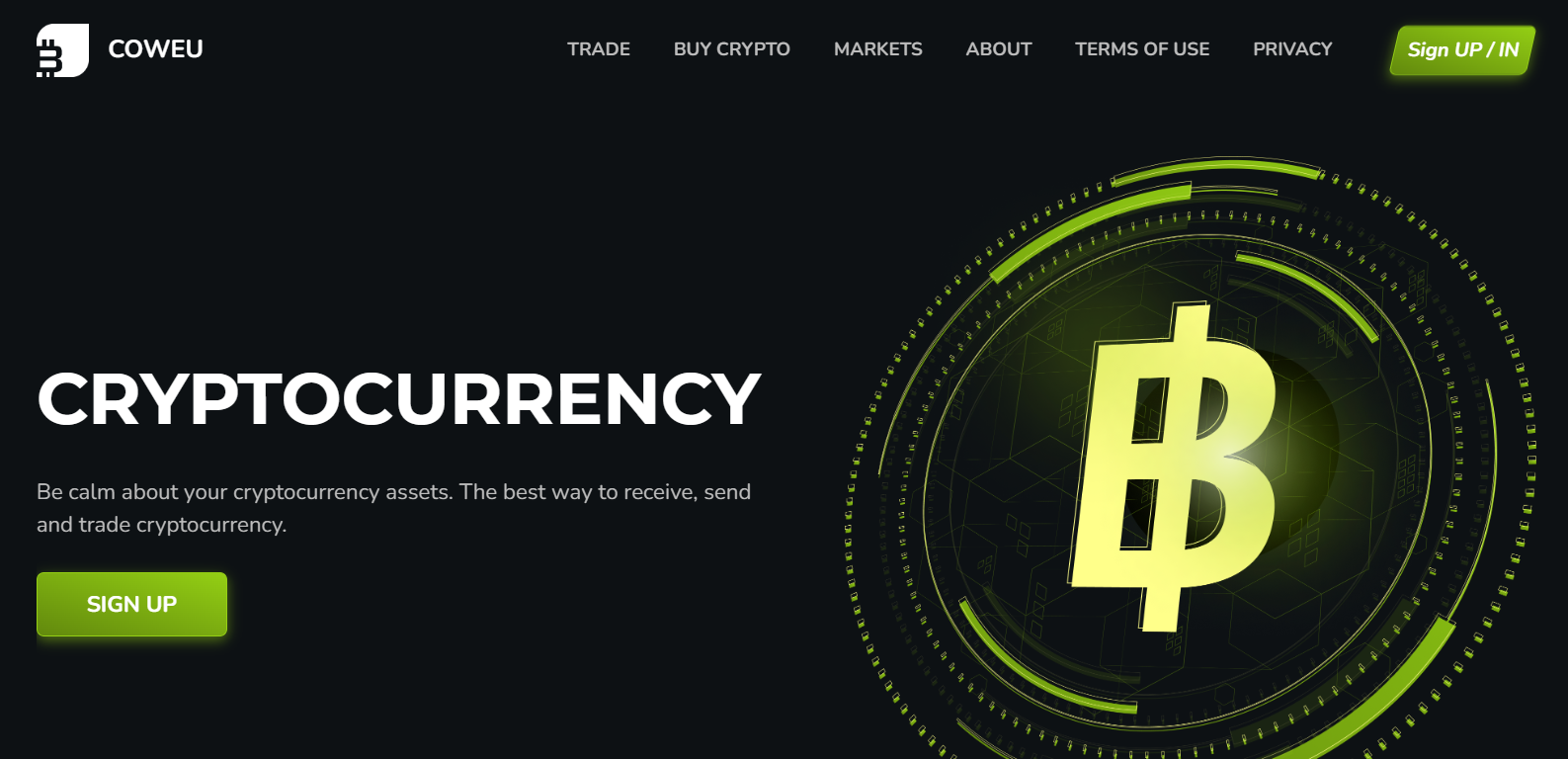Recently, Coweu.com website appeared, promoting itself as a place to keep cryptocurrency and other assets securely. I managed to gather reliable proof that unmistakably reveals it is, actually, a fraudulent site.
Despite the promises of the most user-friendly, reliable, and customer-centric service, Coweu.com does not follow any of them. All this is just a golden wrap around a dirty scam, which takes your funds and never returns them. Any tales about gifts, endorsement from celebrities etc are absent as well.
Coweu Scam Overview
Originally, Coweu poses as a cryptocurrency trading & cryptowallet service with outstandingly low commission fees. Another bright marketing point for this service is partnerships with celebrities that are known in the crypto world. Vitalii Buterin (Ethereum creator), Elon Musk, Jeff Bezos, Bill Gates, Warren Buffet – the site says about being supported by them. To make these claims look real, rascals employ deepfake videos where those celebrities advertise the scam as if it was the best thing in the world. For obvious reasons, Elon Musk is the most common choise for that. But, as I mentioned above, all this is just a vivid wrap around a transparent scam.
First and foremost, Coweu shares the appearance of many equivalent online platforms. There are quite a few examples, like Citzns, Dttsc or Selunox. They are totally identical in terms of graphic elements, with small discrepancies in the site header. Other details, and sometimes even crypto wallet addresses, are unchanged. Presumably, all these deceptive sites are operated by a single team of scammers.
Cryptocurrency Scam Summary
| Website | Coweu.com |
| Hosting | AS13335 Cloudflare, Inc. United States, San Francisco |
| IP Address | 172.67.219.42 |
| Threat Type | Scam/Fraud |
| Scam Type | Fraudulent offers of cryptocurrency services |
How the Coweu Scam Works?
Coweu is a part of a extensive cryptocurrency scam scheme that started circulating vividly in 2023. Swindlers who stand behind it use numerous website designs, which still share the same overall layout. Another mutual element are the ways the scams like NAME are promoted, and the manner all this ends up to the victim of the scam. To reach peak efficiency, frauds apply complex psychological tricks that make the user believe in the authenticity of the website. But let’s review them one by one.
Step 1: Promotion
To start the fraud, criminals create and fill accounts on well-liked social media platforms. They primarily focus on Facebook, Instagram, Twitter, and TikTok. Subsequently, the marketing campaign commences. Employing bots and paid advertisements (when achievable), scam actors increase the presence of their deceptive activities to possible victims. And as I said, scammers do not shy away using generative AI for creating clips with the aforementioned celebrities that promote their scam to the public. To boost the folks even more, frauds claim the bonus for every user who joins the service immediately.

Promotions of cryptoscams like Coweu in TikTok. Most of these videos are AI-generated deepfakes
Users obtain an encouragement to register, enticed by the promise of receiving crypto prizes valued at hundreds of dollars, all free of charge. To enhance the attractiveness of the offer, fake suggestions of sponsorship by a celebrity are incorporated. As you may guess, these claims are completely baseless.
Step 2: Gaining Traffic
After following the ads, victims end up on a page filled with appealing offers. “Crypto starts with Coweu”, “Your crypto savings are secured with Coweu, “Start earning with Coweu – they look rather reliable. To heat up users and make them proceed to step 3, crooks say that obtaining the promoted bonus requires registration. And since nothing concerning happens at this point, unaware users happily proceed – especially as the bonus appears to be right behind the corner.
At this point, it is possible to get away from the scam without any losses. Before you sign up using your personal info, crooks will not earn even a nickel from your presence on the website.
Step 3: Data Gathering
This is the starting poing of the main fraud action. As I just mentioned, frauds bait folks for registration with bonuses. And all the personal information needed for it – email, username, crypto wallet address – are valuable for user identification. Exclusively by gathering this data and selling it further into the Darknet, fraudsters can earn quite a penny. Nonetheless, their plans go much further.
As it turns out, you cannot use the alleged bonus right away. To make it at least usable for cryptocurrency purchases, you need to top up the account with the sum of a bonus. At this point, the final stage of the scam begins.
Step 4: Requesting funds
It is obvious that any crypto operations require having money on your account. In the case of Coweu, users are also coerced to top up to claim the bonuses. And these top ups is what creates most of the cash flow to this scam site. By topping up the account, users hope to get the committed gift (usually $500-1000 in USDT), and may start engaging on this website hoping to use all the transferred funds and withdraw them.
This is where the victim notices the problems. When comparing the real cryptocurrency wallet vs what the website says, you can observe that no transactions are done whatsoever. And then, when you’d try to retrieve the funds from your account, the scam is finally uncovered to the user.
Step 5: Escaping from Funds Withdrawal
There’s no need to explain that scoundrels have zero intentions to send you money. But to make it look more legitimate, they’ve elaborated a whole bunch of reasons to decline the wireout request. Usually, they repeat what Know Your Client requirements say, but for the Coweu.com they are here exclusively to make the wireout impossible.
By requesting your personal information, frauds just stall hoping for you to understand that you’ve been scammed and stop contacting them. If you don’t – well, there are a dozen other checks you should go through before getting your grand back. And each of these checks will reveal more and more information, which – you guessed it right – will be then traded on the Darknet. Never reveal your real info to strangers!
Signs of Scam
I gathered several facts that point at the scammy nature of the Coweu.com. Actually, there are a lot of scams that fall under the same points, so they are pretty much universal.
- Unsubstantiated Credibility. Coweu employs fraudulent celebrity endorsements, often featuring names like Elon Musk, Jeff Bezos, Mr. Beast, and Mark Zuckerberg. These false claims extend to fictitious partnerships with reputable entities like Coinbase, Binance, or MetaMask, despite the absence of genuine connections.
- Implausible Earnings Claims. Promising remarkable returns of 50-100-200%, Coweu exploits the longing for quick profits. However, such gains are unrealistic within the volatile cryptocurrency landscape, unequivocally identifying Coweu as a scam.
- Dubious Corporate Information. Coweu arouses suspicion by providing inadequate documentation about ownership, location, and registration. Furthermore, the lack of legitimate contact information and the recent registration of domain and social media profiles deepen skepticism.
- Exclusive Cryptocurrency Payments. Coweu.com solely accepts payments in cryptocurrencies, refraining from traditional bank transfers and other payment methods. This approach not only shrouds the company’s identity but also prevents the possibility of requesting refunds.
- Potential Pyramid Scheme. The scam relies on a Ponzi-like referral structure disseminated through social media. Nevertheless, only initial participants profit, often at the expense of funds brought in by subsequent members.
- Groundless Hype Tactics. Coweu utilizes fabricated claims about non-existent events, such as securing contracts with Coinbase or receiving endorsements from Elon Musk. This manipulative strategy aims to foster belief in money returns and encourages individuals to top up their accounts again.
What Should I do as a Victim?
If you had to deal with Coweu site and fell victim to that scam, there are still some steps to take. They will make further scam attempts harder, and also boost the knowledge about that scam among folks.
- Immediate Reporting. Your initial step should involve promptly notifying local authorities specializing in financial fraud. Extend your reach by reaching out to wallet providers and engaging with social networks’ technical support teams. These actions serve to raise the bar for the scammers’ operations.
- Share among Friends. Amplify your efforts by informing your close friends about the scam. Similar to informing authorities, this dissemination of information restricts the scammers’ potential victim pool.
- Preserve Crucial Information. Compile a comprehensive evidence archive by capturing screenshots and archiving all relevant website-related data. Collect the website URL, screenshots of the main page, login interface, end-user license agreement (EULA), account top-up menu, and wallet addresses. These records could provide vital clues for authorities in their pursuit of the scammers.
- Exploring Refund Options. While most banks’ refund policies may exclude cryptocurrency payments, it’s advisable to explore potential refund avenues under specific circumstances. Maintain hope until you obtain confirmation of the loss.
- Transform Loss into Knowledge. Turn your financial setback into an opportunity for growth. View your loss as an investment in understanding the strategies employed by crypto scam sites. Familiarize yourself with their telltale characteristics, the methods they employ to entice individuals, and the extravagant promises they make. Equipped with this insight, you’ll be well-prepared to spot and evade future traps without suffering additional financial setbacks.
Scan your system for possible malware infections
Beware of cross scams! Scam actors can use your trust to make you download some stuff or interact with certain documents. It may be a trap that installs malware to your system. There are no moral barriers or limits for these scoundrels.
Throughout the timeline of the scam, scoundrels may reach out to you with specific files. Alternatively, they may suggest you to deploy “cryptocurrency wallet applications” or “browser extensions” to simplify access to your crypto funds. As we earlier figured out, these scoundrels have no intent of returning your capital. So, what do these emails and browser extensions represent? Correct – this is another side of the scam designed to entice you into deliberately installing malicious programs onto your computer.
Both add-ons and files included to emails can serve as a shell for diverse malware. In this scenario, I expect the presence of spyware and stealers among other types of malware. While it is not obligatory for scammers to distribute malware, the probability is always existent. As previously mentioned, their morality is of negligible importance, and their dignity is already deeply compromised. They have nothing to give up and intend to boost profits.
Remove spyware with Gridinsoft Anti-Malware
We have also been using this software on our systems ever since, and it has always been successful in detecting viruses. It has blocked the most common malicious programs as shown from our tests with the software, and we assure you that it can remove spyware as well as other malware hiding on your computer.

To use Gridinsoft for remove malicious threats, follow the steps below:
1. Begin by downloading Gridinsoft Anti-Malware, accessible via the blue button below or directly from the official website gridinsoft.com.
2.Once the Gridinsoft setup file (setup-gridinsoft-fix.exe) is downloaded, execute it by clicking on the file.

3.Follow the installation setup wizard's instructions diligently.

4. Access the "Scan Tab" on the application's start screen and launch a comprehensive "Full Scan" to examine your entire computer. This inclusive scan encompasses the memory, startup items, the registry, services, drivers, and all files, ensuring that it detects malware hidden in all possible locations.

Be patient, as the scan duration depends on the number of files and your computer's hardware capabilities. Use this time to relax or attend to other tasks.
5. Upon completion, Anti-Malware will present a detailed report containing all the detected malicious items and threats on your PC.

6. Select all the identified items from the report and confidently click the "Clean Now" button. This action will safely remove the malicious files from your computer, transferring them to the secure quarantine zone of the anti-malware program to prevent any further harmful actions.

8. If prompted, restart your computer to finalize the full system scan procedure. This step is crucial to ensure thorough removal of any remaining threats. After the restart, Gridinsoft Anti-Malware will open and display a message confirming the completion of the scan.
Remember Gridinsoft offers a 6-day free trial. This means you can take advantage of the trial period at no cost to experience the full benefits of the software and prevent any future malware infections on your system. Embrace this opportunity to fortify your computer's security without any financial commitment.
Frequently asked questions
The vast majority of information posted on the Coweu site is false. It is either fabricated, or a manipulation that misses the context of mentioned events. However, things like quotes or other interactive elements related to current prices may be trustworthy. But I would rather avoid using them as a primary source of information.
No, there is no legitimate information on the Coweu site. The operators of this site use fabricated details and deceptive tactics to create an appearance of credibility, such as appealing visuals and claims of being a licensed company. However, these claims are false, and the site is part of a larger network of interconnected crypto scam sites designed to defraud victims. The scammers manipulate users into providing sensitive personal information and making deposits, ultimately leading to the loss of funds.
Unfortunately, recovering funds lost to a scam like Coweu can be extremely challenging, if not impossible. Scammers often operate from obscure locations and use various tactics to cover their tracks, making it difficult to trace or retrieve the stolen funds. In many cases, these scams are designed to exploit victims and disappear once they have obtained the money.
Spotting crypto trading scams requires vigilance and a critical eye. Here are some tips to help you identify potential crypto trading scams in the future:
- Verify Regulation and Licensing. Before proceeding, ensure that the platform or service is regulated and possesses the necessary licenses from relevant authorities. Scammers often operate without proper authorization.
- Resist Urgency. Be cautious of tactics that create a false sense of urgency to pressure you into quick decisions. Legitimate investments provide ample time for research and consideration.
- Consult Reviews and Feedback. Seek independent reviews and feedback from other traders. While positive reviews can be fabricated, negative reviews often reveal valuable insights.
- Question Unrealistic Promises. Approach offers with unrealistically high returns or guaranteed profits skeptically. If an investment opportunity seems too good to be true, it probably is.
- Scrutinize Celebrity Endorsements. Exercise skepticism when faced with endorsements from celebrities or public figures. Scammers frequently create fake endorsements to enhance credibility.
If you have become a victim of a Coweu or similar crypto trading scam, it’s important to take immediate action to minimize further damage and increase the chances of recovering your losses. Here’s what you should do:
- Cease Communication. If you realize that you’ve been scammed, stop all communication with the scammers. Do not respond to their emails, messages, or calls.
- Document Everything. Gather and preserve all relevant information, including emails, screenshots, transaction records, and any communication you had with the scammers. This documentation will be crucial for reporting the scam and seeking assistance.
- Report to Authorities. File a report with your local law enforcement agency and any relevant regulatory authorities in your country. Provide them with all the evidence you have gathered. This helps initiate investigations and raises awareness about the scam.
- Contact Financial Institutions. If you made any payments or deposits using your credit card or bank account, contact your financial institution immediately. They may be able to help you with disputing transactions or initiating a chargeback.
- Seek Legal Advice. Consult with a legal professional who specializes in fraud or financial matters. They can provide advice on potential legal actions you can take to recover your funds.
- Notify Cryptocurrency Exchanges. If you used a cryptocurrency exchange to make transactions related to the scam, notify the exchange about the fraudulent activity. They may be able to assist you in some cases.
- Monitor Your Accounts. Keep a close eye on your financial and online accounts for any suspicious activity. Change passwords and enable two-factor authentication wherever possible.





